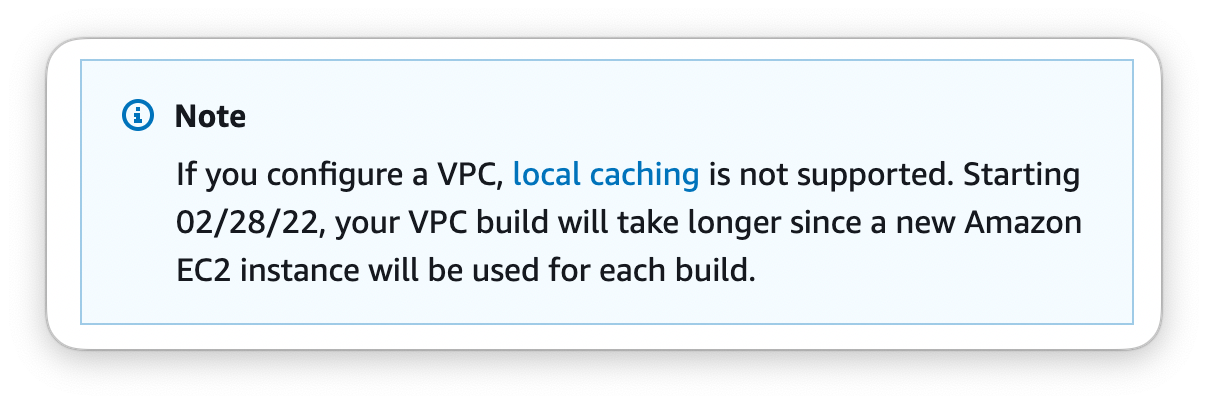AWS VPC data exfiltration using CodeBuild
UPDATE: This issue has been fixed. See the end of the article for timeline and details.
In September 2020, I published a guest blog post on Ian Mckay's blog. The tl;dr is that "escaping" a privileged container running in an Amazon-managed AWS account isn't a security concern for Amazon, thanks to defence-in-depth on both an EC2 and IAM level. Here's a few paragraphs I left out of that blog post at the time.
But wait, there's more¶
As Corey said in the tweet at the start of that story, you can grant CodeBuild access to resources in your own VPC. CodeBuild is much like AWS Lambda in that regard: by default it has public Internet connectivity or you can allow it to attach to your VPC to access internal resources.
A tweet by @amcabee13 on her favourite topic of IP addresses for VPC-unattached Lambdas got me thinking: some people attach Lambdas to VPCs because then it allows more observability and control over data egress, i.e. connections out to the Internet. The same goes for CodeBuild jobs: traffic will now reach the Internet through whatever egress path you have and the associated security controls (firewalls, etc). But what about the EC2 instance the CodeBuild container is running on - it's still in the AWS-managed VPC?
So naturally, I went back and checked. Running commands in the container had connectivity to the VPC. And running them on the host had connectivity directly to the public Internet, unassociated with the customer's (my) VPC. Could this make for very convenient data exfiltration? The answer is: yes, quite easy!
First, run commands like these on the CodeBuild host:
ssh-keygen
cat ~/.ssh/id_rsa.pub > /home/ec2-user/.ssh/authorized_keys
ssh -f -N -D 169.254.170.8:1080 ec2-user@localhost
Now in the CodeBuild container you can run:
# this is routed through the customer VPC
curl http://10.1.2.3/internal
# this is routed through the AWS VPC, bypassing your VPC egress routing tables
curl --socks4a 169.254.170.8:1080 https://google.com
Pay careful attention to the a at the end of that --socks4a flag. If you
instead pass --socks4 everything will work, but the DNS resolution of google.com
will be done by the container and your malicious DNS queries could be recorded
by Route 53 Resolver Query Logs in the customer VPC, not the AWS VPC.
What would be better?¶
The CodeBuild host EC2 instance seems to only need Internet connectivity in
order to connect to codebuild.{region}.amazonaws.com and associated services.
Instead of using a NAT gateway, perhaps the AWS-managed VPC could use interface
VPC endpoints. That would eliminate the issue entirely.
That said, do I consider this a huge issue? Not really. CodeBuild builds are logged in CloudTrail and CodeBuild itself, so forensics are easy enough. It's unlikely that this is going to be a problem in reality. But I found it fun and worth sharing.
Update¶
I reported this to the AWS Security team on February 4th. My initial email was acknowledged by a human within 6 hours. On the 24th of February I got an update with this (emphasis my own):
CodeBuild executes customer builds in containers which run on single-tenanted Amazon EC2 instances within a service-managed VPC. When customers configure a CodeBuild project with their VPC, CodeBuild's build container will apply the same network routing rules as defined in the customer's VPC Security Group. We have updated the CodeBuild service to block all outbound network access for newly created CodeBuild projects, which contain a customer-defined VPC configuration.
CodeBuild's security isolation is enforced at the AWS account level and EC2 instances are never shared across AWS accounts. CodeBuild also logs all build requests in CloudTrail for auditing usage within an AWS account.
I verified that the issue in this article is no longer applicable for new CodeBuild
projects. codebuild.{region}.amazonaws.com and other host-level dependencies
use VPC endpoints and there is no connectivity to the public Internet for VPC-attached
projects.
Honestly, I'm delighted with the outcome. Making this kind of change to a service as well-established as AWS CodeBuild likely isn't straight forward, but the AWS security team and the CodeBuild team managed to identify, develop and roll out the ideal fix in fewer than three weeks. Kudos to them.
That said, I did notice this new caveat appear in the CodeBuild VPC docs and I feel bad for anyone whose builds are slower now! Hopefully it's only a minor increase.
